Cost Accounting: Core Concepts, Methods, and Applications
VerifiedAdded on 2022/01/21
|19
|7215
|79
Homework Assignment
AI Summary
This assignment delves into the core concepts of cost accounting, starting with the fundamental reasons for its existence in business. It defines cost accounting, contrasting it with financial accounting and highlighting their complementary roles. The document outlines the differences between financial and management accounting, emphasizing the distinct objectives and information needs they serve. It then compares cost accounting with management accounting, elucidating their relationship and the activities involved in each. Furthermore, the assignment lists the advantages of a well-organized cost accounting system, such as improved decision-making and cost control. Key terms like 'cost' and 'expenditure' are defined, and the concepts of cost ascertainment and cost estimation are explained, including their differences and respective uses. The document provides a comprehensive introduction to the field, suitable for students learning the basics of cost accounting.
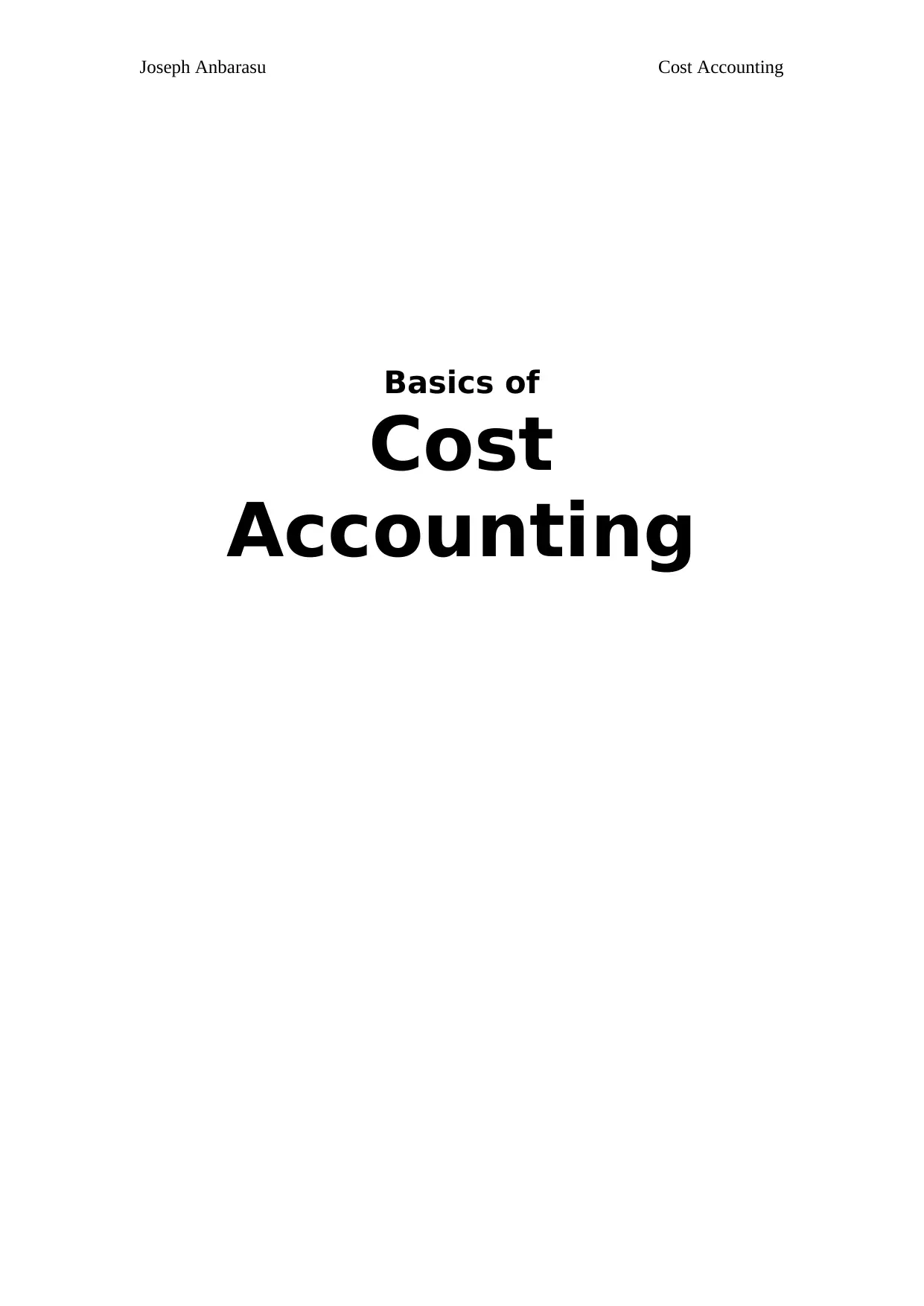
Joseph Anbarasu
Basics of
Cost
Accounting
Cost Accounting
Basics of
Cost
Accounting
Cost Accounting
Paraphrase This Document
Need a fresh take? Get an instant paraphrase of this document with our AI Paraphraser
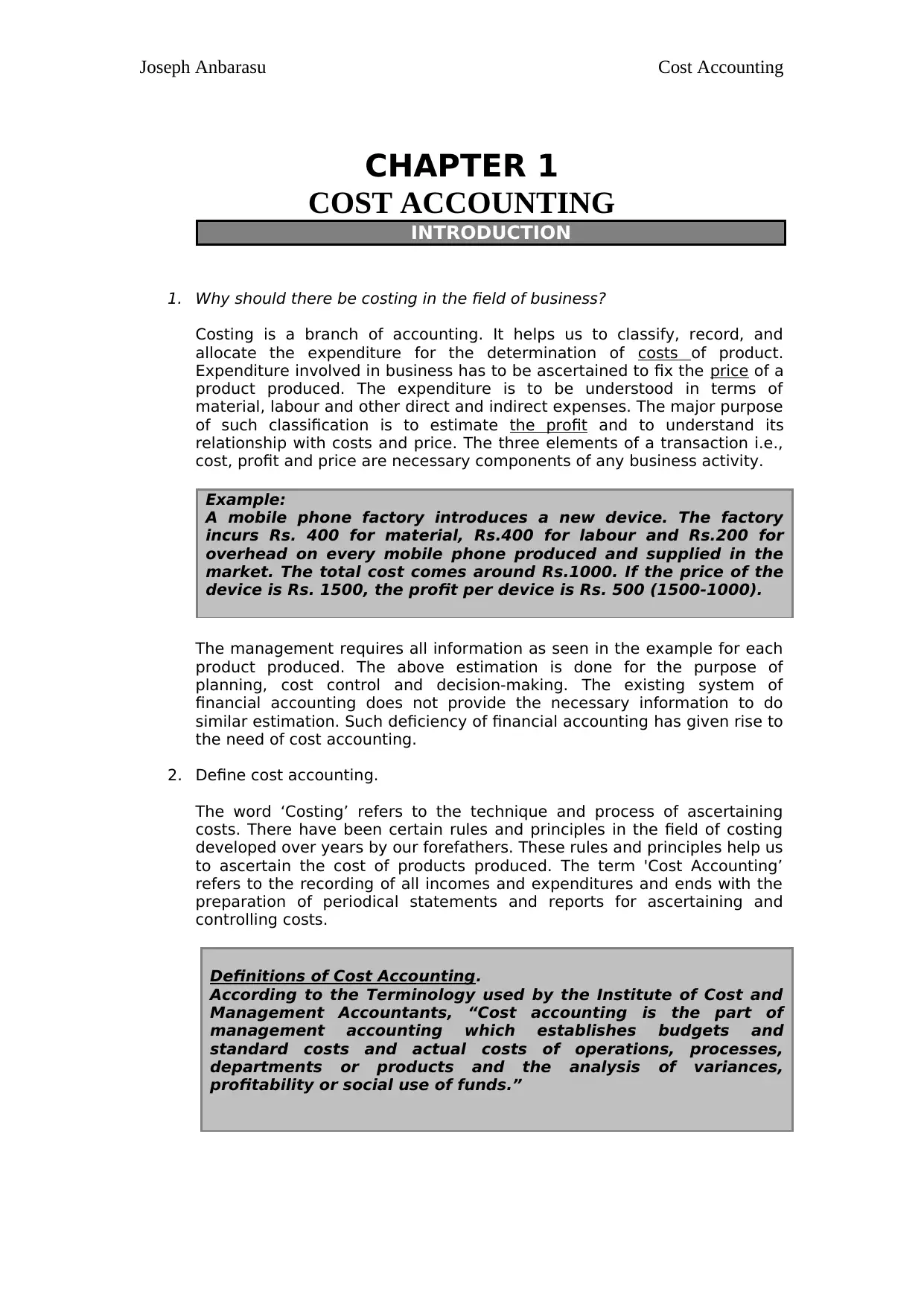
Joseph Anbarasu
CHAPTER 1
COST ACCOUNTING
INTRODUCTION
1. Why should there be costing in the field of business?
Costing is a branch of accounting. It helps us to classify, record, and
allocate the expenditure for the determination of costs of product.
Expenditure involved in business has to be ascertained to fix the price of a
product produced. The expenditure is to be understood in terms of
material, labour and other direct and indirect expenses. The major purpose
of such classification is to estimate the profit and to understand its
relationship with costs and price. The three elements of a transaction i.e.,
cost, profit and price are necessary components of any business activity.
Example:
A mobile phone factory introduces a new device. The factory
incurs Rs. 400 for material, Rs.400 for labour and Rs.200 for
overhead on every mobile phone produced and supplied in the
market. The total cost comes around Rs.1000. If the price of the
device is Rs. 1500, the profit per device is Rs. 500 (1500-1000).
The management requires all information as seen in the example for each
product produced. The above estimation is done for the purpose of
planning, cost control and decision-making. The existing system of
financial accounting does not provide the necessary information to do
similar estimation. Such deficiency of financial accounting has given rise to
the need of cost accounting.
2. Define cost accounting.
The word ‘Costing’ refers to the technique and process of ascertaining
costs. There have been certain rules and principles in the field of costing
developed over years by our forefathers. These rules and principles help us
to ascertain the cost of products produced. The term 'Cost Accounting’
refers to the recording of all incomes and expenditures and ends with the
preparation of periodical statements and reports for ascertaining and
controlling costs.
Definitions of Cost Accounting.
According to the Terminology used by the Institute of Cost and
Management Accountants, “Cost accounting is the part of
management accounting which establishes budgets and
standard costs and actual costs of operations, processes,
departments or products and the analysis of variances,
profitability or social use of funds.”
Cost Accounting
CHAPTER 1
COST ACCOUNTING
INTRODUCTION
1. Why should there be costing in the field of business?
Costing is a branch of accounting. It helps us to classify, record, and
allocate the expenditure for the determination of costs of product.
Expenditure involved in business has to be ascertained to fix the price of a
product produced. The expenditure is to be understood in terms of
material, labour and other direct and indirect expenses. The major purpose
of such classification is to estimate the profit and to understand its
relationship with costs and price. The three elements of a transaction i.e.,
cost, profit and price are necessary components of any business activity.
Example:
A mobile phone factory introduces a new device. The factory
incurs Rs. 400 for material, Rs.400 for labour and Rs.200 for
overhead on every mobile phone produced and supplied in the
market. The total cost comes around Rs.1000. If the price of the
device is Rs. 1500, the profit per device is Rs. 500 (1500-1000).
The management requires all information as seen in the example for each
product produced. The above estimation is done for the purpose of
planning, cost control and decision-making. The existing system of
financial accounting does not provide the necessary information to do
similar estimation. Such deficiency of financial accounting has given rise to
the need of cost accounting.
2. Define cost accounting.
The word ‘Costing’ refers to the technique and process of ascertaining
costs. There have been certain rules and principles in the field of costing
developed over years by our forefathers. These rules and principles help us
to ascertain the cost of products produced. The term 'Cost Accounting’
refers to the recording of all incomes and expenditures and ends with the
preparation of periodical statements and reports for ascertaining and
controlling costs.
Definitions of Cost Accounting.
According to the Terminology used by the Institute of Cost and
Management Accountants, “Cost accounting is the part of
management accounting which establishes budgets and
standard costs and actual costs of operations, processes,
departments or products and the analysis of variances,
profitability or social use of funds.”
Cost Accounting
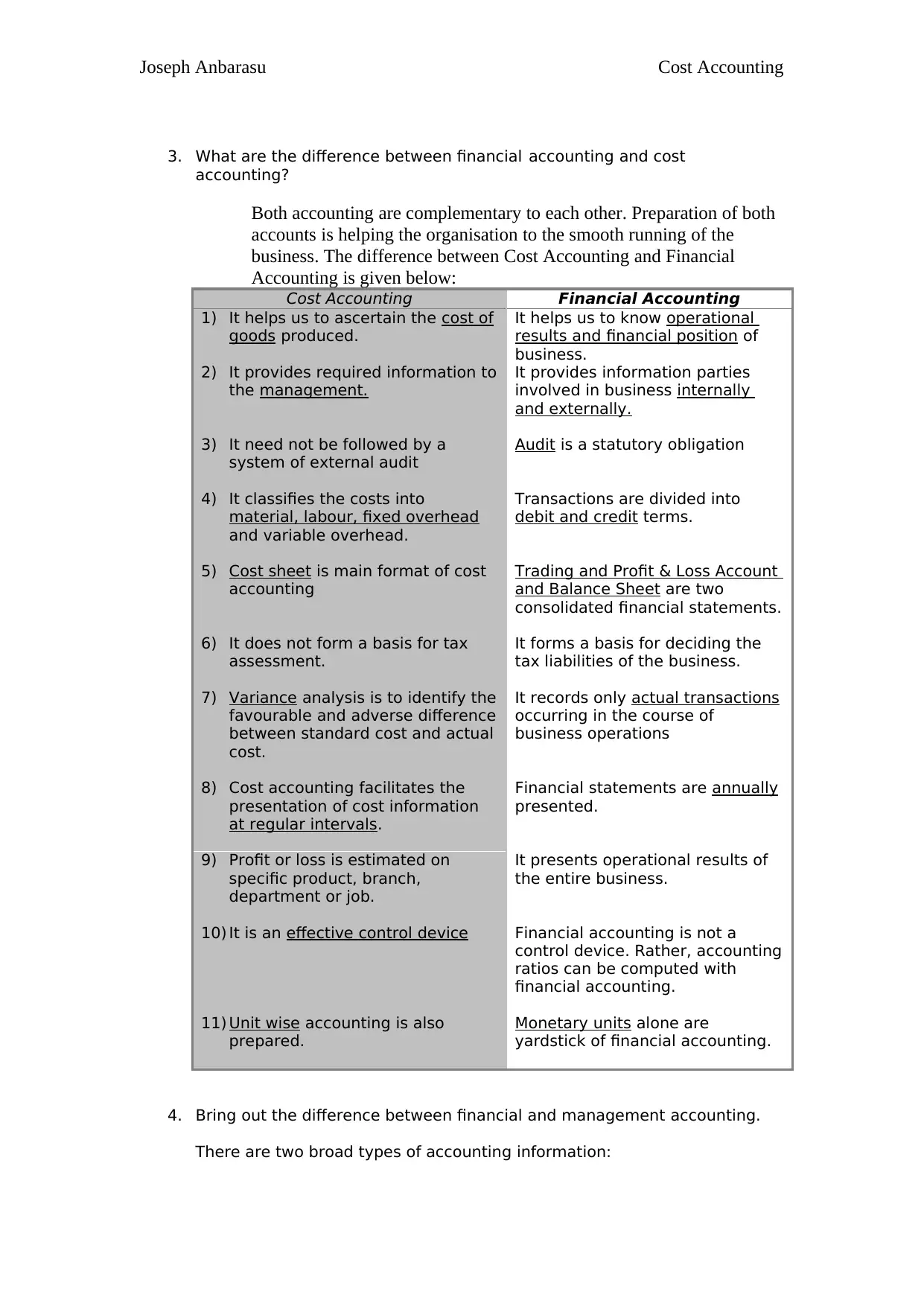
Joseph Anbarasu
3. What are the difference between financial accounting and cost
accounting?
Both accounting are complementary to each other. Preparation of both
accounts is helping the organisation to the smooth running of the
business. The difference between Cost Accounting and Financial
Accounting is given below:
Cost Accounting Financial Accounting
1) It helps us to ascertain the cost of
goods produced.
It helps us to know operational
results and financial position of
business.
2) It provides required information to
the management.
It provides information parties
involved in business internally
and externally.
3) It need not be followed by a
system of external audit
Audit is a statutory obligation
4) It classifies the costs into
material, labour, fixed overhead
and variable overhead.
Transactions are divided into
debit and credit terms.
5) Cost sheet is main format of cost
accounting
Trading and Profit & Loss Account
and Balance Sheet are two
consolidated financial statements.
6) It does not form a basis for tax
assessment.
It forms a basis for deciding the
tax liabilities of the business.
7) Variance analysis is to identify the
favourable and adverse difference
between standard cost and actual
cost.
It records only actual transactions
occurring in the course of
business operations
8) Cost accounting facilitates the
presentation of cost information
at regular intervals.
Financial statements are annually
presented.
9) Profit or loss is estimated on
specific product, branch,
department or job.
It presents operational results of
the entire business.
10) It is an effective control device Financial accounting is not a
control device. Rather, accounting
ratios can be computed with
financial accounting.
11) Unit wise accounting is also
prepared.
Monetary units alone are
yardstick of financial accounting.
4. Bring out the difference between financial and management accounting.
There are two broad types of accounting information:
Cost Accounting
3. What are the difference between financial accounting and cost
accounting?
Both accounting are complementary to each other. Preparation of both
accounts is helping the organisation to the smooth running of the
business. The difference between Cost Accounting and Financial
Accounting is given below:
Cost Accounting Financial Accounting
1) It helps us to ascertain the cost of
goods produced.
It helps us to know operational
results and financial position of
business.
2) It provides required information to
the management.
It provides information parties
involved in business internally
and externally.
3) It need not be followed by a
system of external audit
Audit is a statutory obligation
4) It classifies the costs into
material, labour, fixed overhead
and variable overhead.
Transactions are divided into
debit and credit terms.
5) Cost sheet is main format of cost
accounting
Trading and Profit & Loss Account
and Balance Sheet are two
consolidated financial statements.
6) It does not form a basis for tax
assessment.
It forms a basis for deciding the
tax liabilities of the business.
7) Variance analysis is to identify the
favourable and adverse difference
between standard cost and actual
cost.
It records only actual transactions
occurring in the course of
business operations
8) Cost accounting facilitates the
presentation of cost information
at regular intervals.
Financial statements are annually
presented.
9) Profit or loss is estimated on
specific product, branch,
department or job.
It presents operational results of
the entire business.
10) It is an effective control device Financial accounting is not a
control device. Rather, accounting
ratios can be computed with
financial accounting.
11) Unit wise accounting is also
prepared.
Monetary units alone are
yardstick of financial accounting.
4. Bring out the difference between financial and management accounting.
There are two broad types of accounting information:
Cost Accounting
⊘ This is a preview!⊘
Do you want full access?
Subscribe today to unlock all pages.

Trusted by 1+ million students worldwide
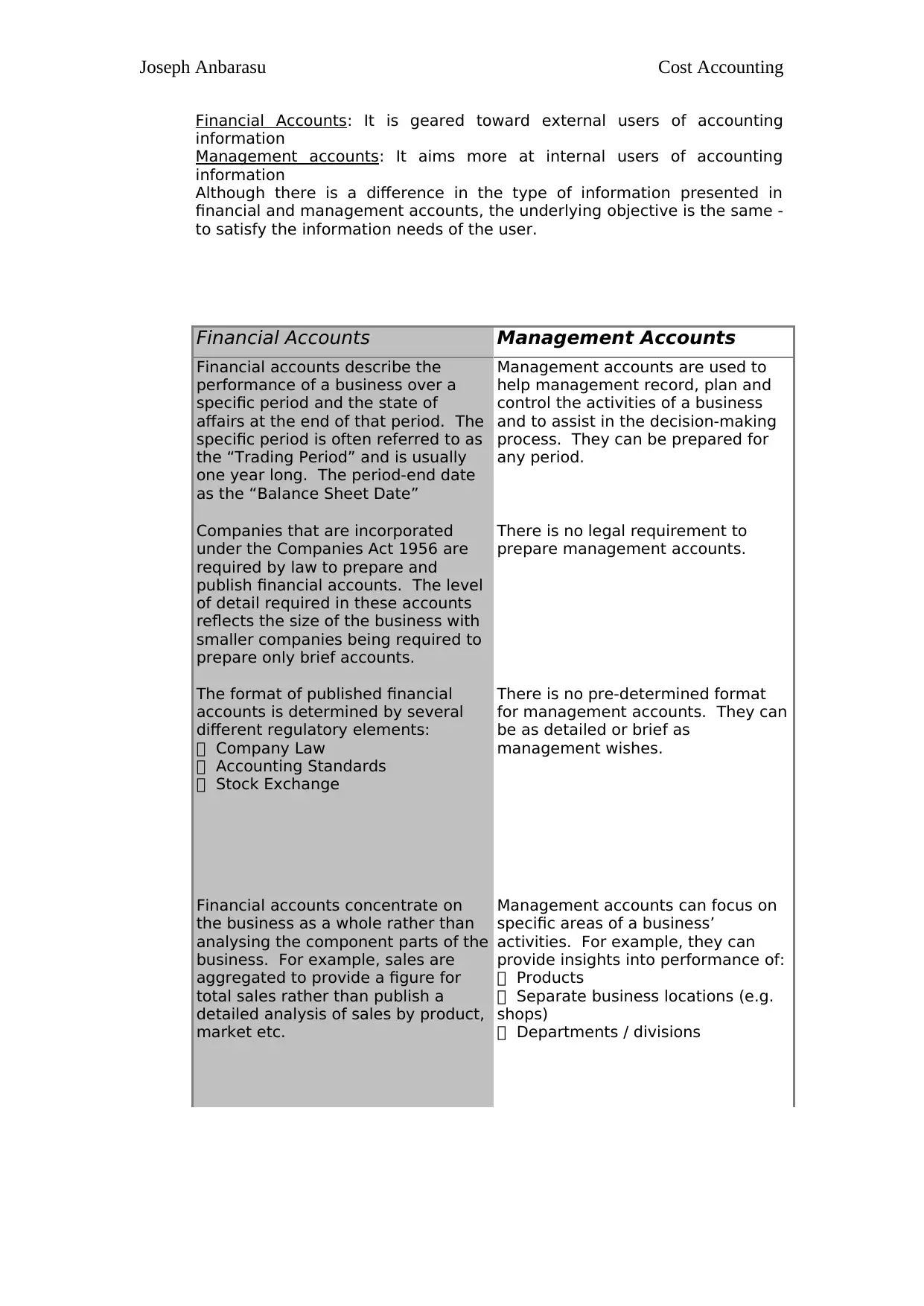
Joseph Anbarasu
Financial Accounts: It is geared toward external users of accounting
information
Management accounts: It aims more at internal users of accounting
information
Although there is a difference in the type of information presented in
financial and management accounts, the underlying objective is the same -
to satisfy the information needs of the user.
Financial Accounts Management Accounts
Financial accounts describe the
performance of a business over a
specific period and the state of
affairs at the end of that period. The
specific period is often referred to as
the “Trading Period” and is usually
one year long. The period-end date
as the “Balance Sheet Date”
Management accounts are used to
help management record, plan and
control the activities of a business
and to assist in the decision-making
process. They can be prepared for
any period.
Companies that are incorporated
under the Companies Act 1956 are
required by law to prepare and
publish financial accounts. The level
of detail required in these accounts
reflects the size of the business with
smaller companies being required to
prepare only brief accounts.
There is no legal requirement to
prepare management accounts.
The format of published financial
accounts is determined by several
different regulatory elements:
Company Law
Accounting Standards
Stock Exchange
There is no pre-determined format
for management accounts. They can
be as detailed or brief as
management wishes.
Financial accounts concentrate on
the business as a whole rather than
analysing the component parts of the
business. For example, sales are
aggregated to provide a figure for
total sales rather than publish a
detailed analysis of sales by product,
market etc.
Management accounts can focus on
specific areas of a business’
activities. For example, they can
provide insights into performance of:
Products
Separate business locations (e.g.
shops)
Departments / divisions
Cost Accounting
Financial Accounts: It is geared toward external users of accounting
information
Management accounts: It aims more at internal users of accounting
information
Although there is a difference in the type of information presented in
financial and management accounts, the underlying objective is the same -
to satisfy the information needs of the user.
Financial Accounts Management Accounts
Financial accounts describe the
performance of a business over a
specific period and the state of
affairs at the end of that period. The
specific period is often referred to as
the “Trading Period” and is usually
one year long. The period-end date
as the “Balance Sheet Date”
Management accounts are used to
help management record, plan and
control the activities of a business
and to assist in the decision-making
process. They can be prepared for
any period.
Companies that are incorporated
under the Companies Act 1956 are
required by law to prepare and
publish financial accounts. The level
of detail required in these accounts
reflects the size of the business with
smaller companies being required to
prepare only brief accounts.
There is no legal requirement to
prepare management accounts.
The format of published financial
accounts is determined by several
different regulatory elements:
Company Law
Accounting Standards
Stock Exchange
There is no pre-determined format
for management accounts. They can
be as detailed or brief as
management wishes.
Financial accounts concentrate on
the business as a whole rather than
analysing the component parts of the
business. For example, sales are
aggregated to provide a figure for
total sales rather than publish a
detailed analysis of sales by product,
market etc.
Management accounts can focus on
specific areas of a business’
activities. For example, they can
provide insights into performance of:
Products
Separate business locations (e.g.
shops)
Departments / divisions
Cost Accounting
Paraphrase This Document
Need a fresh take? Get an instant paraphrase of this document with our AI Paraphraser
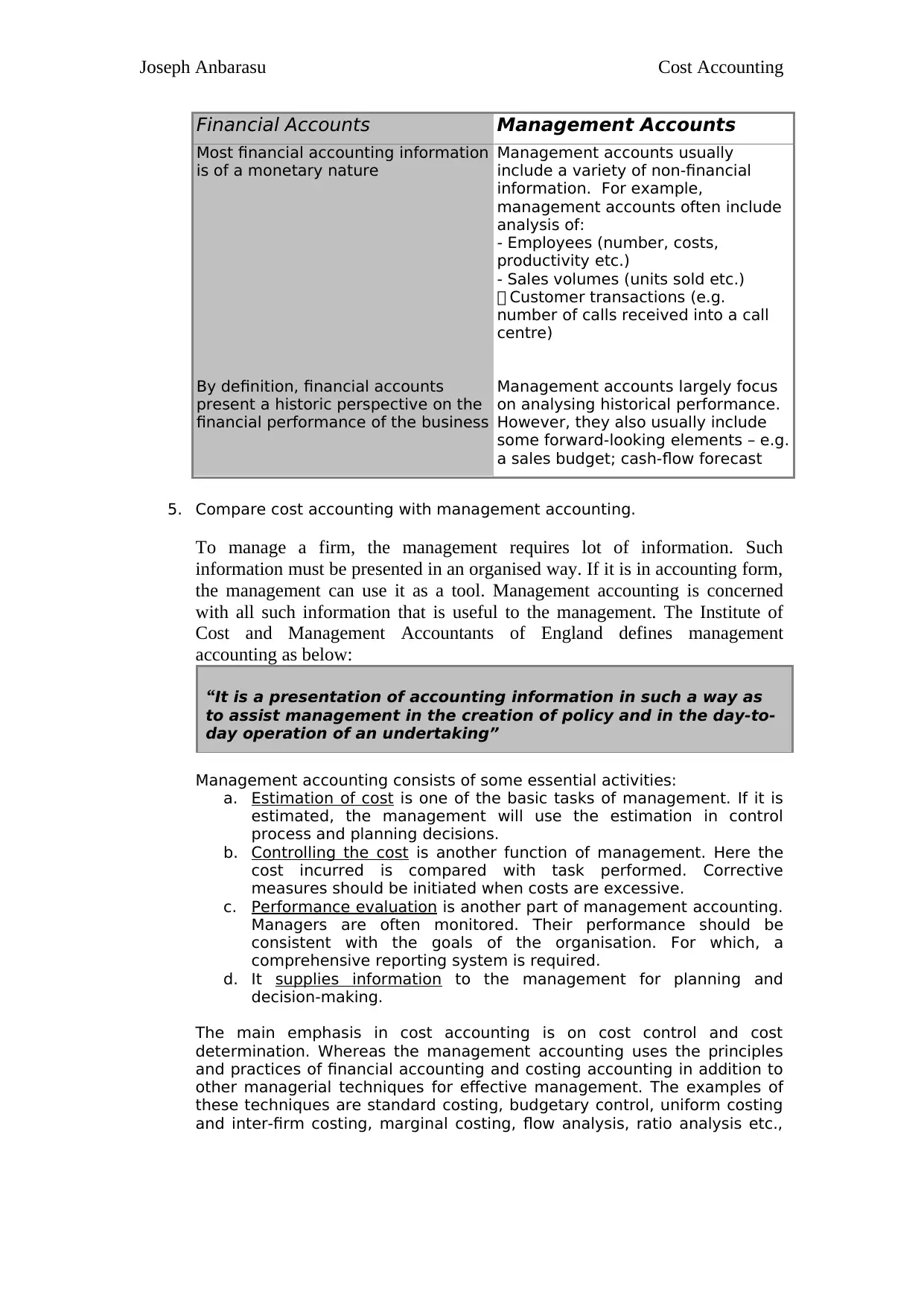
Joseph Anbarasu
Financial Accounts Management Accounts
Most financial accounting information
is of a monetary nature
Management accounts usually
include a variety of non-financial
information. For example,
management accounts often include
analysis of:
- Employees (number, costs,
productivity etc.)
- Sales volumes (units sold etc.)
Customer transactions (e.g.
number of calls received into a call
centre)
By definition, financial accounts
present a historic perspective on the
financial performance of the business
Management accounts largely focus
on analysing historical performance.
However, they also usually include
some forward-looking elements – e.g.
a sales budget; cash-flow forecast
5. Compare cost accounting with management accounting.
To manage a firm, the management requires lot of information. Such
information must be presented in an organised way. If it is in accounting form,
the management can use it as a tool. Management accounting is concerned
with all such information that is useful to the management. The Institute of
Cost and Management Accountants of England defines management
accounting as below:
“It is a presentation of accounting information in such a way as
to assist management in the creation of policy and in the day-to-
day operation of an undertaking”
Management accounting consists of some essential activities:
a. Estimation of cost is one of the basic tasks of management. If it is
estimated, the management will use the estimation in control
process and planning decisions.
b. Controlling the cost is another function of management. Here the
cost incurred is compared with task performed. Corrective
measures should be initiated when costs are excessive.
c. Performance evaluation is another part of management accounting.
Managers are often monitored. Their performance should be
consistent with the goals of the organisation. For which, a
comprehensive reporting system is required.
d. It supplies information to the management for planning and
decision-making.
The main emphasis in cost accounting is on cost control and cost
determination. Whereas the management accounting uses the principles
and practices of financial accounting and costing accounting in addition to
other managerial techniques for effective management. The examples of
these techniques are standard costing, budgetary control, uniform costing
and inter-firm costing, marginal costing, flow analysis, ratio analysis etc.,
Cost Accounting
Financial Accounts Management Accounts
Most financial accounting information
is of a monetary nature
Management accounts usually
include a variety of non-financial
information. For example,
management accounts often include
analysis of:
- Employees (number, costs,
productivity etc.)
- Sales volumes (units sold etc.)
Customer transactions (e.g.
number of calls received into a call
centre)
By definition, financial accounts
present a historic perspective on the
financial performance of the business
Management accounts largely focus
on analysing historical performance.
However, they also usually include
some forward-looking elements – e.g.
a sales budget; cash-flow forecast
5. Compare cost accounting with management accounting.
To manage a firm, the management requires lot of information. Such
information must be presented in an organised way. If it is in accounting form,
the management can use it as a tool. Management accounting is concerned
with all such information that is useful to the management. The Institute of
Cost and Management Accountants of England defines management
accounting as below:
“It is a presentation of accounting information in such a way as
to assist management in the creation of policy and in the day-to-
day operation of an undertaking”
Management accounting consists of some essential activities:
a. Estimation of cost is one of the basic tasks of management. If it is
estimated, the management will use the estimation in control
process and planning decisions.
b. Controlling the cost is another function of management. Here the
cost incurred is compared with task performed. Corrective
measures should be initiated when costs are excessive.
c. Performance evaluation is another part of management accounting.
Managers are often monitored. Their performance should be
consistent with the goals of the organisation. For which, a
comprehensive reporting system is required.
d. It supplies information to the management for planning and
decision-making.
The main emphasis in cost accounting is on cost control and cost
determination. Whereas the management accounting uses the principles
and practices of financial accounting and costing accounting in addition to
other managerial techniques for effective management. The examples of
these techniques are standard costing, budgetary control, uniform costing
and inter-firm costing, marginal costing, flow analysis, ratio analysis etc.,
Cost Accounting
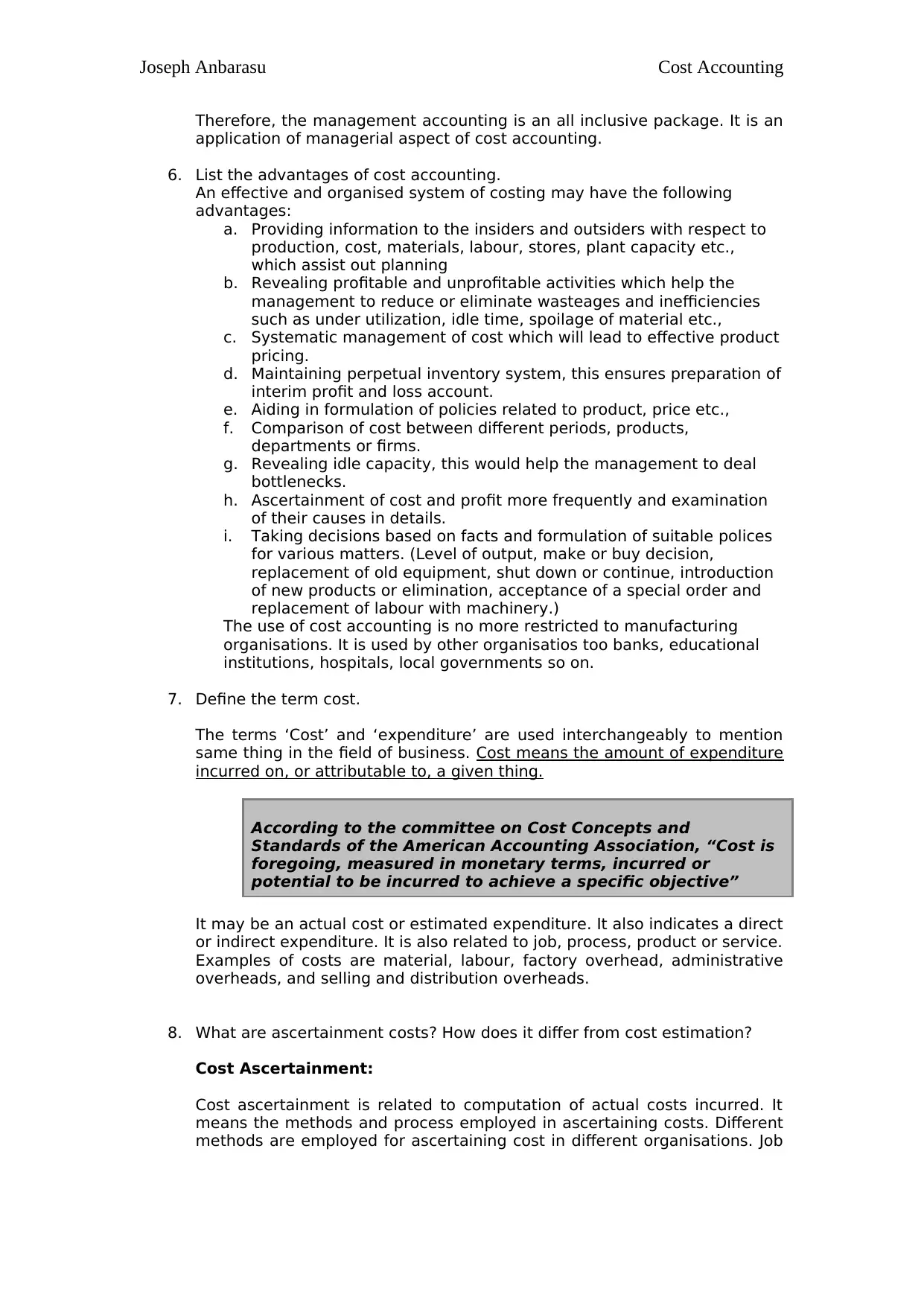
Joseph Anbarasu
Therefore, the management accounting is an all inclusive package. It is an
application of managerial aspect of cost accounting.
6. List the advantages of cost accounting.
An effective and organised system of costing may have the following
advantages:
a. Providing information to the insiders and outsiders with respect to
production, cost, materials, labour, stores, plant capacity etc.,
which assist out planning
b. Revealing profitable and unprofitable activities which help the
management to reduce or eliminate wasteages and inefficiencies
such as under utilization, idle time, spoilage of material etc.,
c. Systematic management of cost which will lead to effective product
pricing.
d. Maintaining perpetual inventory system, this ensures preparation of
interim profit and loss account.
e. Aiding in formulation of policies related to product, price etc.,
f. Comparison of cost between different periods, products,
departments or firms.
g. Revealing idle capacity, this would help the management to deal
bottlenecks.
h. Ascertainment of cost and profit more frequently and examination
of their causes in details.
i. Taking decisions based on facts and formulation of suitable polices
for various matters. (Level of output, make or buy decision,
replacement of old equipment, shut down or continue, introduction
of new products or elimination, acceptance of a special order and
replacement of labour with machinery.)
The use of cost accounting is no more restricted to manufacturing
organisations. It is used by other organisatios too banks, educational
institutions, hospitals, local governments so on.
7. Define the term cost.
The terms ‘Cost’ and ‘expenditure’ are used interchangeably to mention
same thing in the field of business. Cost means the amount of expenditure
incurred on, or attributable to, a given thing.
According to the committee on Cost Concepts and
Standards of the American Accounting Association, “Cost is
foregoing, measured in monetary terms, incurred or
potential to be incurred to achieve a specific objective”
It may be an actual cost or estimated expenditure. It also indicates a direct
or indirect expenditure. It is also related to job, process, product or service.
Examples of costs are material, labour, factory overhead, administrative
overheads, and selling and distribution overheads.
8. What are ascertainment costs? How does it differ from cost estimation?
Cost Ascertainment:
Cost ascertainment is related to computation of actual costs incurred. It
means the methods and process employed in ascertaining costs. Different
methods are employed for ascertaining cost in different organisations. Job
Cost Accounting
Therefore, the management accounting is an all inclusive package. It is an
application of managerial aspect of cost accounting.
6. List the advantages of cost accounting.
An effective and organised system of costing may have the following
advantages:
a. Providing information to the insiders and outsiders with respect to
production, cost, materials, labour, stores, plant capacity etc.,
which assist out planning
b. Revealing profitable and unprofitable activities which help the
management to reduce or eliminate wasteages and inefficiencies
such as under utilization, idle time, spoilage of material etc.,
c. Systematic management of cost which will lead to effective product
pricing.
d. Maintaining perpetual inventory system, this ensures preparation of
interim profit and loss account.
e. Aiding in formulation of policies related to product, price etc.,
f. Comparison of cost between different periods, products,
departments or firms.
g. Revealing idle capacity, this would help the management to deal
bottlenecks.
h. Ascertainment of cost and profit more frequently and examination
of their causes in details.
i. Taking decisions based on facts and formulation of suitable polices
for various matters. (Level of output, make or buy decision,
replacement of old equipment, shut down or continue, introduction
of new products or elimination, acceptance of a special order and
replacement of labour with machinery.)
The use of cost accounting is no more restricted to manufacturing
organisations. It is used by other organisatios too banks, educational
institutions, hospitals, local governments so on.
7. Define the term cost.
The terms ‘Cost’ and ‘expenditure’ are used interchangeably to mention
same thing in the field of business. Cost means the amount of expenditure
incurred on, or attributable to, a given thing.
According to the committee on Cost Concepts and
Standards of the American Accounting Association, “Cost is
foregoing, measured in monetary terms, incurred or
potential to be incurred to achieve a specific objective”
It may be an actual cost or estimated expenditure. It also indicates a direct
or indirect expenditure. It is also related to job, process, product or service.
Examples of costs are material, labour, factory overhead, administrative
overheads, and selling and distribution overheads.
8. What are ascertainment costs? How does it differ from cost estimation?
Cost Ascertainment:
Cost ascertainment is related to computation of actual costs incurred. It
means the methods and process employed in ascertaining costs. Different
methods are employed for ascertaining cost in different organisations. Job
Cost Accounting
⊘ This is a preview!⊘
Do you want full access?
Subscribe today to unlock all pages.

Trusted by 1+ million students worldwide
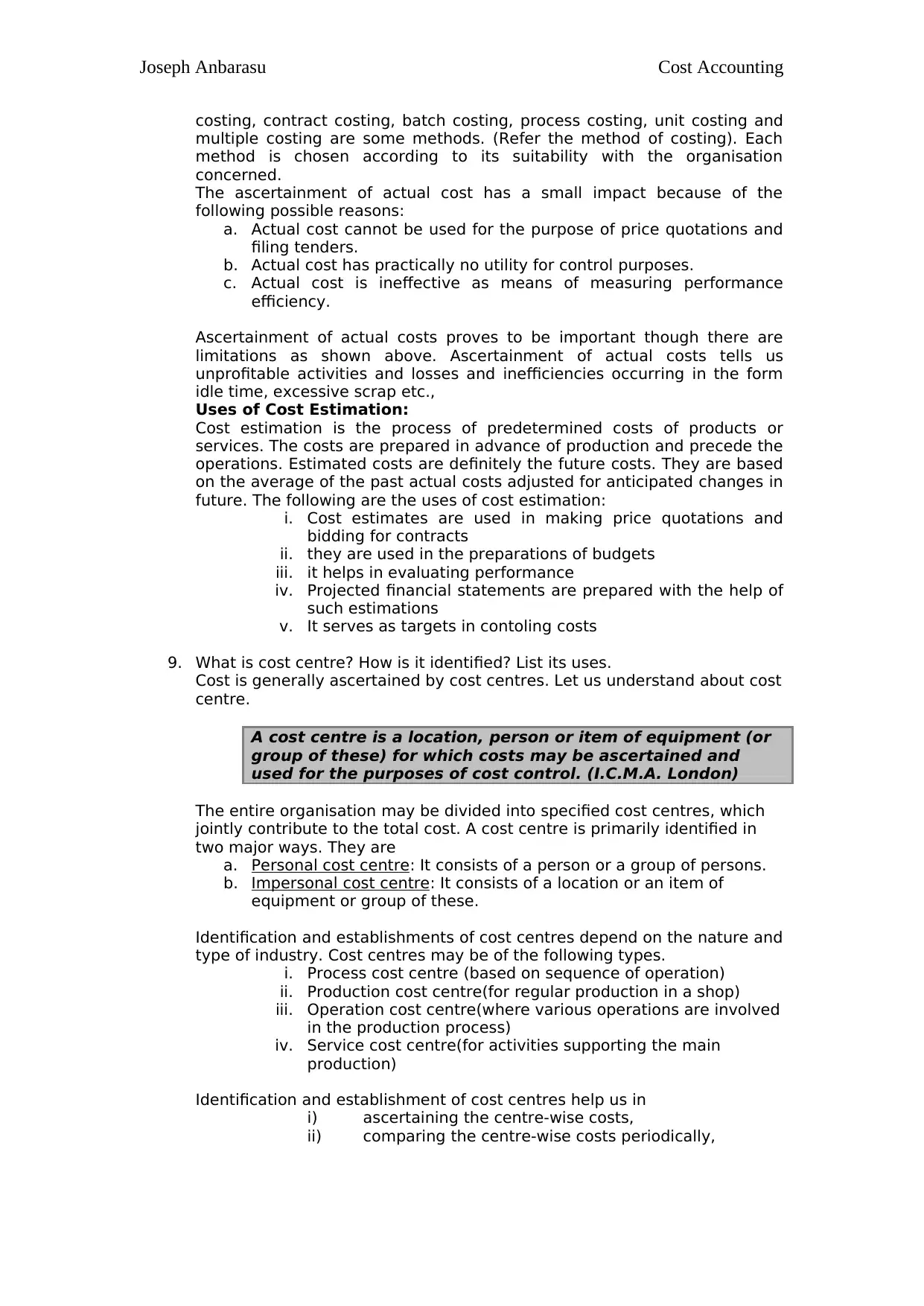
Joseph Anbarasu
costing, contract costing, batch costing, process costing, unit costing and
multiple costing are some methods. (Refer the method of costing). Each
method is chosen according to its suitability with the organisation
concerned.
The ascertainment of actual cost has a small impact because of the
following possible reasons:
a. Actual cost cannot be used for the purpose of price quotations and
filing tenders.
b. Actual cost has practically no utility for control purposes.
c. Actual cost is ineffective as means of measuring performance
efficiency.
Ascertainment of actual costs proves to be important though there are
limitations as shown above. Ascertainment of actual costs tells us
unprofitable activities and losses and inefficiencies occurring in the form
idle time, excessive scrap etc.,
Uses of Cost Estimation:
Cost estimation is the process of predetermined costs of products or
services. The costs are prepared in advance of production and precede the
operations. Estimated costs are definitely the future costs. They are based
on the average of the past actual costs adjusted for anticipated changes in
future. The following are the uses of cost estimation:
i. Cost estimates are used in making price quotations and
bidding for contracts
ii. they are used in the preparations of budgets
iii. it helps in evaluating performance
iv. Projected financial statements are prepared with the help of
such estimations
v. It serves as targets in contoling costs
9. What is cost centre? How is it identified? List its uses.
Cost is generally ascertained by cost centres. Let us understand about cost
centre.
A cost centre is a location, person or item of equipment (or
group of these) for which costs may be ascertained and
used for the purposes of cost control. (I.C.M.A. London)
The entire organisation may be divided into specified cost centres, which
jointly contribute to the total cost. A cost centre is primarily identified in
two major ways. They are
a. Personal cost centre: It consists of a person or a group of persons.
b. Impersonal cost centre: It consists of a location or an item of
equipment or group of these.
Identification and establishments of cost centres depend on the nature and
type of industry. Cost centres may be of the following types.
i. Process cost centre (based on sequence of operation)
ii. Production cost centre(for regular production in a shop)
iii. Operation cost centre(where various operations are involved
in the production process)
iv. Service cost centre(for activities supporting the main
production)
Identification and establishment of cost centres help us in
i) ascertaining the centre-wise costs,
ii) comparing the centre-wise costs periodically,
Cost Accounting
costing, contract costing, batch costing, process costing, unit costing and
multiple costing are some methods. (Refer the method of costing). Each
method is chosen according to its suitability with the organisation
concerned.
The ascertainment of actual cost has a small impact because of the
following possible reasons:
a. Actual cost cannot be used for the purpose of price quotations and
filing tenders.
b. Actual cost has practically no utility for control purposes.
c. Actual cost is ineffective as means of measuring performance
efficiency.
Ascertainment of actual costs proves to be important though there are
limitations as shown above. Ascertainment of actual costs tells us
unprofitable activities and losses and inefficiencies occurring in the form
idle time, excessive scrap etc.,
Uses of Cost Estimation:
Cost estimation is the process of predetermined costs of products or
services. The costs are prepared in advance of production and precede the
operations. Estimated costs are definitely the future costs. They are based
on the average of the past actual costs adjusted for anticipated changes in
future. The following are the uses of cost estimation:
i. Cost estimates are used in making price quotations and
bidding for contracts
ii. they are used in the preparations of budgets
iii. it helps in evaluating performance
iv. Projected financial statements are prepared with the help of
such estimations
v. It serves as targets in contoling costs
9. What is cost centre? How is it identified? List its uses.
Cost is generally ascertained by cost centres. Let us understand about cost
centre.
A cost centre is a location, person or item of equipment (or
group of these) for which costs may be ascertained and
used for the purposes of cost control. (I.C.M.A. London)
The entire organisation may be divided into specified cost centres, which
jointly contribute to the total cost. A cost centre is primarily identified in
two major ways. They are
a. Personal cost centre: It consists of a person or a group of persons.
b. Impersonal cost centre: It consists of a location or an item of
equipment or group of these.
Identification and establishments of cost centres depend on the nature and
type of industry. Cost centres may be of the following types.
i. Process cost centre (based on sequence of operation)
ii. Production cost centre(for regular production in a shop)
iii. Operation cost centre(where various operations are involved
in the production process)
iv. Service cost centre(for activities supporting the main
production)
Identification and establishment of cost centres help us in
i) ascertaining the centre-wise costs,
ii) comparing the centre-wise costs periodically,
Cost Accounting
Paraphrase This Document
Need a fresh take? Get an instant paraphrase of this document with our AI Paraphraser
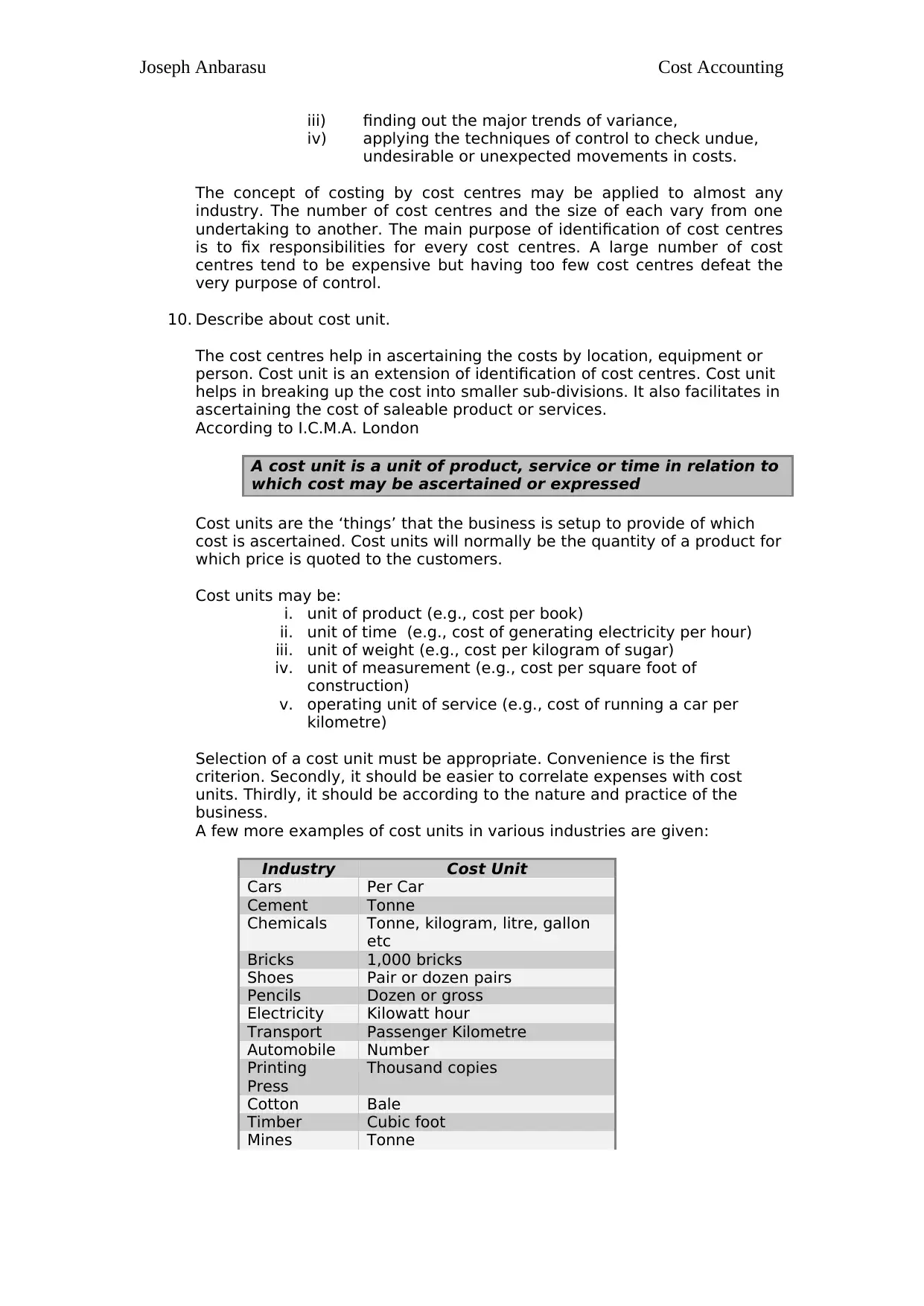
Joseph Anbarasu
iii) finding out the major trends of variance,
iv) applying the techniques of control to check undue,
undesirable or unexpected movements in costs.
The concept of costing by cost centres may be applied to almost any
industry. The number of cost centres and the size of each vary from one
undertaking to another. The main purpose of identification of cost centres
is to fix responsibilities for every cost centres. A large number of cost
centres tend to be expensive but having too few cost centres defeat the
very purpose of control.
10. Describe about cost unit.
The cost centres help in ascertaining the costs by location, equipment or
person. Cost unit is an extension of identification of cost centres. Cost unit
helps in breaking up the cost into smaller sub-divisions. It also facilitates in
ascertaining the cost of saleable product or services.
According to I.C.M.A. London
A cost unit is a unit of product, service or time in relation to
which cost may be ascertained or expressed
Cost units are the ‘things’ that the business is setup to provide of which
cost is ascertained. Cost units will normally be the quantity of a product for
which price is quoted to the customers.
Cost units may be:
i. unit of product (e.g., cost per book)
ii. unit of time (e.g., cost of generating electricity per hour)
iii. unit of weight (e.g., cost per kilogram of sugar)
iv. unit of measurement (e.g., cost per square foot of
construction)
v. operating unit of service (e.g., cost of running a car per
kilometre)
Selection of a cost unit must be appropriate. Convenience is the first
criterion. Secondly, it should be easier to correlate expenses with cost
units. Thirdly, it should be according to the nature and practice of the
business.
A few more examples of cost units in various industries are given:
Industry Cost Unit
Cars Per Car
Cement Tonne
Chemicals Tonne, kilogram, litre, gallon
etc
Bricks 1,000 bricks
Shoes Pair or dozen pairs
Pencils Dozen or gross
Electricity Kilowatt hour
Transport Passenger Kilometre
Automobile Number
Printing
Press
Thousand copies
Cotton Bale
Timber Cubic foot
Mines Tonne
Cost Accounting
iii) finding out the major trends of variance,
iv) applying the techniques of control to check undue,
undesirable or unexpected movements in costs.
The concept of costing by cost centres may be applied to almost any
industry. The number of cost centres and the size of each vary from one
undertaking to another. The main purpose of identification of cost centres
is to fix responsibilities for every cost centres. A large number of cost
centres tend to be expensive but having too few cost centres defeat the
very purpose of control.
10. Describe about cost unit.
The cost centres help in ascertaining the costs by location, equipment or
person. Cost unit is an extension of identification of cost centres. Cost unit
helps in breaking up the cost into smaller sub-divisions. It also facilitates in
ascertaining the cost of saleable product or services.
According to I.C.M.A. London
A cost unit is a unit of product, service or time in relation to
which cost may be ascertained or expressed
Cost units are the ‘things’ that the business is setup to provide of which
cost is ascertained. Cost units will normally be the quantity of a product for
which price is quoted to the customers.
Cost units may be:
i. unit of product (e.g., cost per book)
ii. unit of time (e.g., cost of generating electricity per hour)
iii. unit of weight (e.g., cost per kilogram of sugar)
iv. unit of measurement (e.g., cost per square foot of
construction)
v. operating unit of service (e.g., cost of running a car per
kilometre)
Selection of a cost unit must be appropriate. Convenience is the first
criterion. Secondly, it should be easier to correlate expenses with cost
units. Thirdly, it should be according to the nature and practice of the
business.
A few more examples of cost units in various industries are given:
Industry Cost Unit
Cars Per Car
Cement Tonne
Chemicals Tonne, kilogram, litre, gallon
etc
Bricks 1,000 bricks
Shoes Pair or dozen pairs
Pencils Dozen or gross
Electricity Kilowatt hour
Transport Passenger Kilometre
Automobile Number
Printing
Press
Thousand copies
Cotton Bale
Timber Cubic foot
Mines Tonne
Cost Accounting
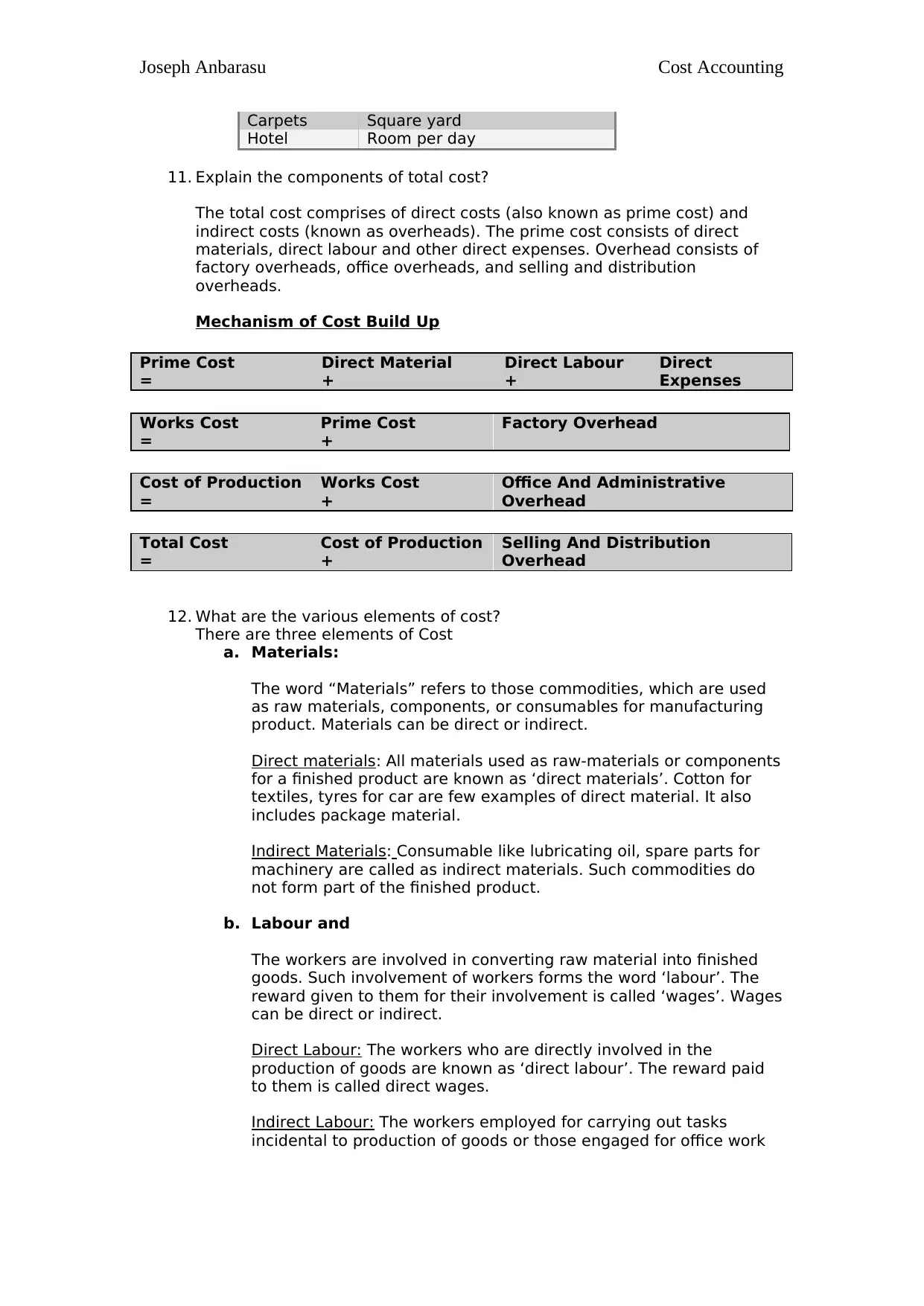
Joseph Anbarasu
Carpets Square yard
Hotel Room per day
11. Explain the components of total cost?
The total cost comprises of direct costs (also known as prime cost) and
indirect costs (known as overheads). The prime cost consists of direct
materials, direct labour and other direct expenses. Overhead consists of
factory overheads, office overheads, and selling and distribution
overheads.
Mechanism of Cost Build Up
Prime Cost
=
Direct Material
+
Direct Labour
+
Direct
Expenses
Works Cost
=
Prime Cost
+
Factory Overhead
Cost of Production
=
Works Cost
+
Office And Administrative
Overhead
Total Cost
=
Cost of Production
+
Selling And Distribution
Overhead
12. What are the various elements of cost?
There are three elements of Cost
a. Materials:
The word “Materials” refers to those commodities, which are used
as raw materials, components, or consumables for manufacturing
product. Materials can be direct or indirect.
Direct materials: All materials used as raw-materials or components
for a finished product are known as ‘direct materials’. Cotton for
textiles, tyres for car are few examples of direct material. It also
includes package material.
Indirect Materials: Consumable like lubricating oil, spare parts for
machinery are called as indirect materials. Such commodities do
not form part of the finished product.
b. Labour and
The workers are involved in converting raw material into finished
goods. Such involvement of workers forms the word ‘labour’. The
reward given to them for their involvement is called ‘wages’. Wages
can be direct or indirect.
Direct Labour: The workers who are directly involved in the
production of goods are known as ‘direct labour’. The reward paid
to them is called direct wages.
Indirect Labour: The workers employed for carrying out tasks
incidental to production of goods or those engaged for office work
Cost Accounting
Carpets Square yard
Hotel Room per day
11. Explain the components of total cost?
The total cost comprises of direct costs (also known as prime cost) and
indirect costs (known as overheads). The prime cost consists of direct
materials, direct labour and other direct expenses. Overhead consists of
factory overheads, office overheads, and selling and distribution
overheads.
Mechanism of Cost Build Up
Prime Cost
=
Direct Material
+
Direct Labour
+
Direct
Expenses
Works Cost
=
Prime Cost
+
Factory Overhead
Cost of Production
=
Works Cost
+
Office And Administrative
Overhead
Total Cost
=
Cost of Production
+
Selling And Distribution
Overhead
12. What are the various elements of cost?
There are three elements of Cost
a. Materials:
The word “Materials” refers to those commodities, which are used
as raw materials, components, or consumables for manufacturing
product. Materials can be direct or indirect.
Direct materials: All materials used as raw-materials or components
for a finished product are known as ‘direct materials’. Cotton for
textiles, tyres for car are few examples of direct material. It also
includes package material.
Indirect Materials: Consumable like lubricating oil, spare parts for
machinery are called as indirect materials. Such commodities do
not form part of the finished product.
b. Labour and
The workers are involved in converting raw material into finished
goods. Such involvement of workers forms the word ‘labour’. The
reward given to them for their involvement is called ‘wages’. Wages
can be direct or indirect.
Direct Labour: The workers who are directly involved in the
production of goods are known as ‘direct labour’. The reward paid
to them is called direct wages.
Indirect Labour: The workers employed for carrying out tasks
incidental to production of goods or those engaged for office work
Cost Accounting
⊘ This is a preview!⊘
Do you want full access?
Subscribe today to unlock all pages.

Trusted by 1+ million students worldwide
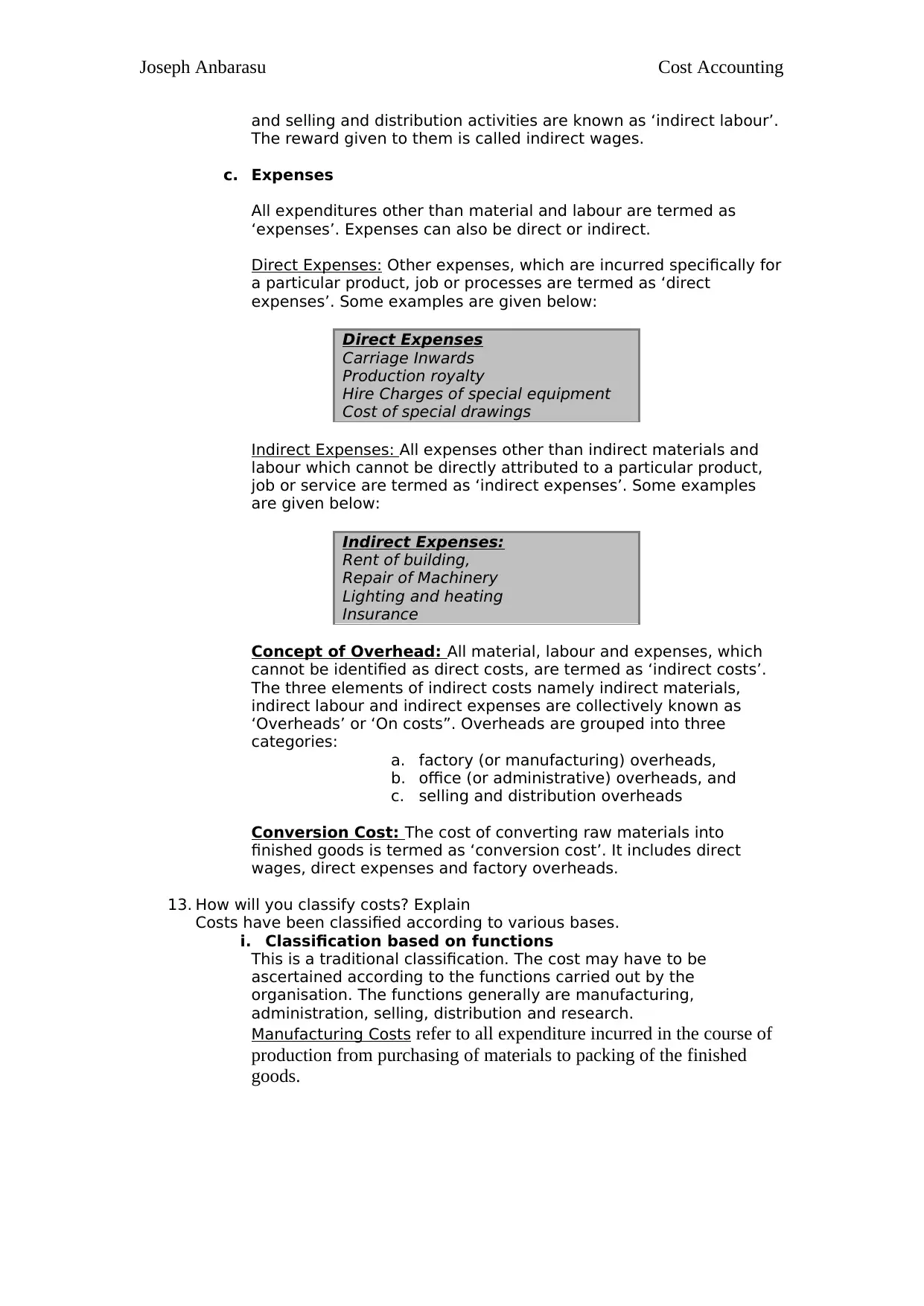
Joseph Anbarasu
and selling and distribution activities are known as ‘indirect labour’.
The reward given to them is called indirect wages.
c. Expenses
All expenditures other than material and labour are termed as
‘expenses’. Expenses can also be direct or indirect.
Direct Expenses: Other expenses, which are incurred specifically for
a particular product, job or processes are termed as ‘direct
expenses’. Some examples are given below:
Direct Expenses
Carriage Inwards
Production royalty
Hire Charges of special equipment
Cost of special drawings
Indirect Expenses: All expenses other than indirect materials and
labour which cannot be directly attributed to a particular product,
job or service are termed as ‘indirect expenses’. Some examples
are given below:
Indirect Expenses:
Rent of building,
Repair of Machinery
Lighting and heating
Insurance
Concept of Overhead: All material, labour and expenses, which
cannot be identified as direct costs, are termed as ‘indirect costs’.
The three elements of indirect costs namely indirect materials,
indirect labour and indirect expenses are collectively known as
‘Overheads’ or ‘On costs”. Overheads are grouped into three
categories:
a. factory (or manufacturing) overheads,
b. office (or administrative) overheads, and
c. selling and distribution overheads
Conversion Cost: The cost of converting raw materials into
finished goods is termed as ‘conversion cost’. It includes direct
wages, direct expenses and factory overheads.
13. How will you classify costs? Explain
Costs have been classified according to various bases.
i. Classification based on functions
This is a traditional classification. The cost may have to be
ascertained according to the functions carried out by the
organisation. The functions generally are manufacturing,
administration, selling, distribution and research.
Manufacturing Costs refer to all expenditure incurred in the course of
production from purchasing of materials to packing of the finished
goods.
Cost Accounting
and selling and distribution activities are known as ‘indirect labour’.
The reward given to them is called indirect wages.
c. Expenses
All expenditures other than material and labour are termed as
‘expenses’. Expenses can also be direct or indirect.
Direct Expenses: Other expenses, which are incurred specifically for
a particular product, job or processes are termed as ‘direct
expenses’. Some examples are given below:
Direct Expenses
Carriage Inwards
Production royalty
Hire Charges of special equipment
Cost of special drawings
Indirect Expenses: All expenses other than indirect materials and
labour which cannot be directly attributed to a particular product,
job or service are termed as ‘indirect expenses’. Some examples
are given below:
Indirect Expenses:
Rent of building,
Repair of Machinery
Lighting and heating
Insurance
Concept of Overhead: All material, labour and expenses, which
cannot be identified as direct costs, are termed as ‘indirect costs’.
The three elements of indirect costs namely indirect materials,
indirect labour and indirect expenses are collectively known as
‘Overheads’ or ‘On costs”. Overheads are grouped into three
categories:
a. factory (or manufacturing) overheads,
b. office (or administrative) overheads, and
c. selling and distribution overheads
Conversion Cost: The cost of converting raw materials into
finished goods is termed as ‘conversion cost’. It includes direct
wages, direct expenses and factory overheads.
13. How will you classify costs? Explain
Costs have been classified according to various bases.
i. Classification based on functions
This is a traditional classification. The cost may have to be
ascertained according to the functions carried out by the
organisation. The functions generally are manufacturing,
administration, selling, distribution and research.
Manufacturing Costs refer to all expenditure incurred in the course of
production from purchasing of materials to packing of the finished
goods.
Cost Accounting
Paraphrase This Document
Need a fresh take? Get an instant paraphrase of this document with our AI Paraphraser
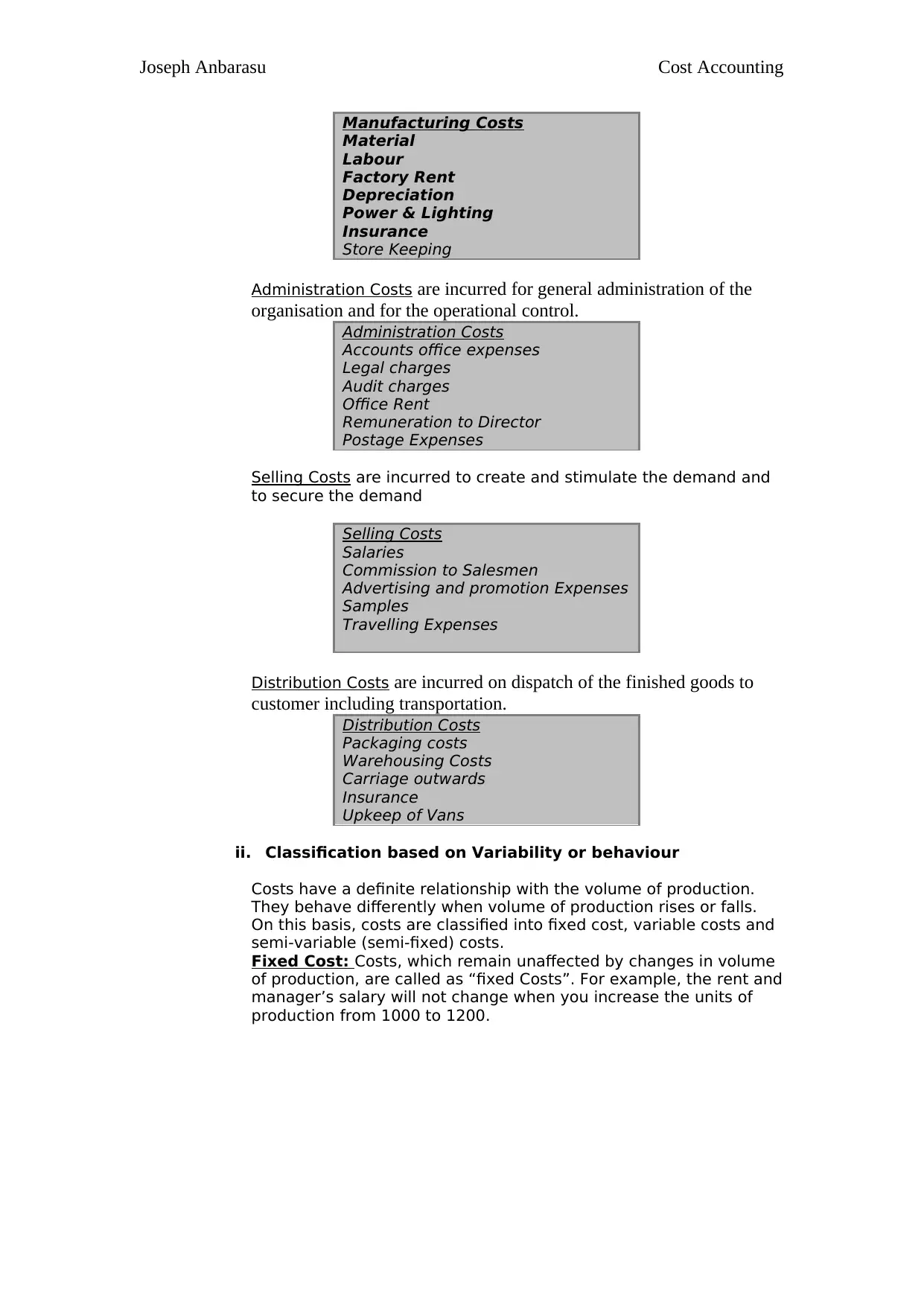
Joseph Anbarasu
Manufacturing Costs
Material
Labour
Factory Rent
Depreciation
Power & Lighting
Insurance
Store Keeping
Administration Costs are incurred for general administration of the
organisation and for the operational control.
Administration Costs
Accounts office expenses
Legal charges
Audit charges
Office Rent
Remuneration to Director
Postage Expenses
Selling Costs are incurred to create and stimulate the demand and
to secure the demand
Selling Costs
Salaries
Commission to Salesmen
Advertising and promotion Expenses
Samples
Travelling Expenses
Distribution Costs are incurred on dispatch of the finished goods to
customer including transportation.
Distribution Costs
Packaging costs
Warehousing Costs
Carriage outwards
Insurance
Upkeep of Vans
ii. Classification based on Variability or behaviour
Costs have a definite relationship with the volume of production.
They behave differently when volume of production rises or falls.
On this basis, costs are classified into fixed cost, variable costs and
semi-variable (semi-fixed) costs.
Fixed Cost: Costs, which remain unaffected by changes in volume
of production, are called as “fixed Costs”. For example, the rent and
manager’s salary will not change when you increase the units of
production from 1000 to 1200.
Cost Accounting
Manufacturing Costs
Material
Labour
Factory Rent
Depreciation
Power & Lighting
Insurance
Store Keeping
Administration Costs are incurred for general administration of the
organisation and for the operational control.
Administration Costs
Accounts office expenses
Legal charges
Audit charges
Office Rent
Remuneration to Director
Postage Expenses
Selling Costs are incurred to create and stimulate the demand and
to secure the demand
Selling Costs
Salaries
Commission to Salesmen
Advertising and promotion Expenses
Samples
Travelling Expenses
Distribution Costs are incurred on dispatch of the finished goods to
customer including transportation.
Distribution Costs
Packaging costs
Warehousing Costs
Carriage outwards
Insurance
Upkeep of Vans
ii. Classification based on Variability or behaviour
Costs have a definite relationship with the volume of production.
They behave differently when volume of production rises or falls.
On this basis, costs are classified into fixed cost, variable costs and
semi-variable (semi-fixed) costs.
Fixed Cost: Costs, which remain unaffected by changes in volume
of production, are called as “fixed Costs”. For example, the rent and
manager’s salary will not change when you increase the units of
production from 1000 to 1200.
Cost Accounting
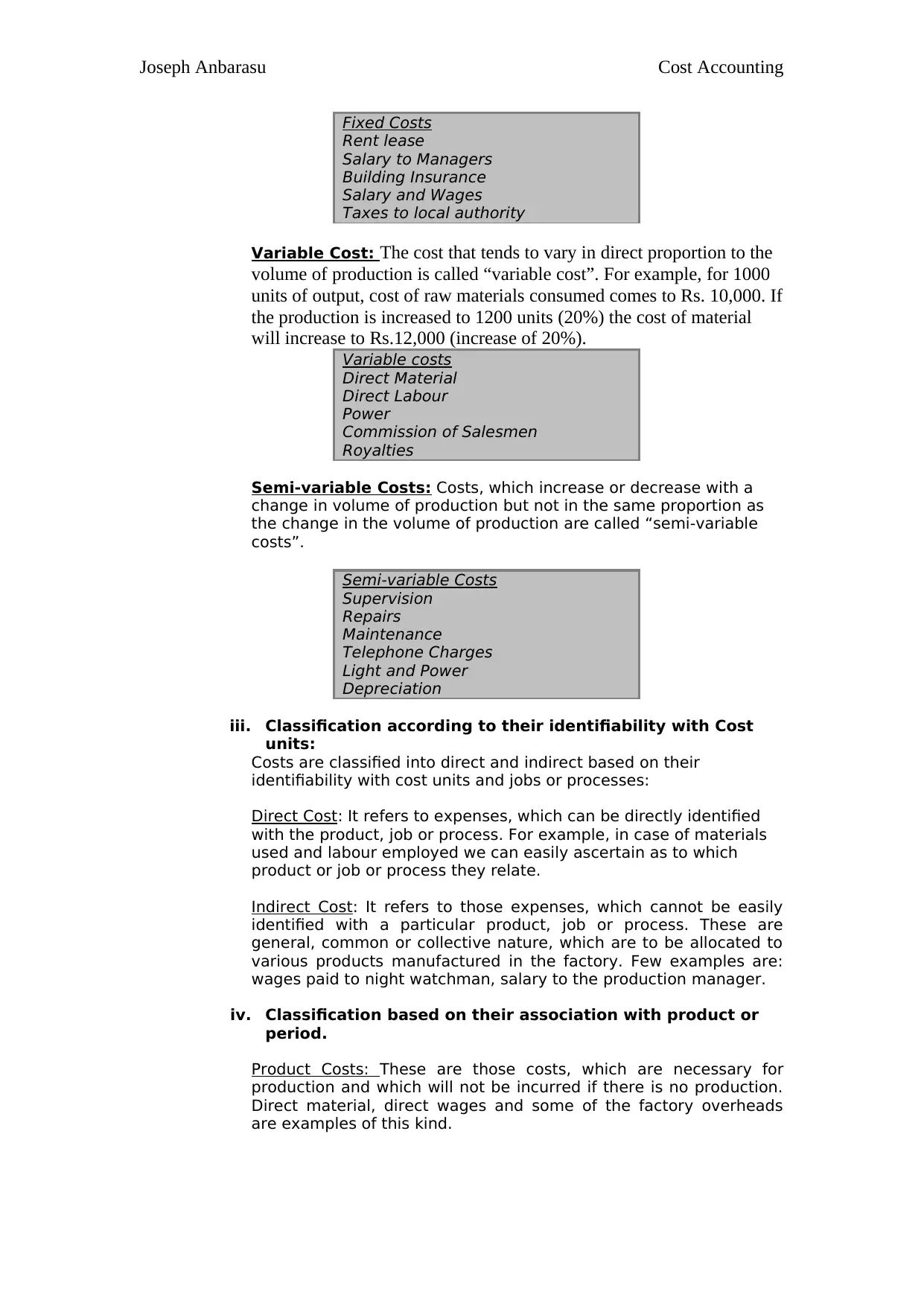
Joseph Anbarasu
Fixed Costs
Rent lease
Salary to Managers
Building Insurance
Salary and Wages
Taxes to local authority
Variable Cost: The cost that tends to vary in direct proportion to the
volume of production is called “variable cost”. For example, for 1000
units of output, cost of raw materials consumed comes to Rs. 10,000. If
the production is increased to 1200 units (20%) the cost of material
will increase to Rs.12,000 (increase of 20%).
Variable costs
Direct Material
Direct Labour
Power
Commission of Salesmen
Royalties
Semi-variable Costs: Costs, which increase or decrease with a
change in volume of production but not in the same proportion as
the change in the volume of production are called “semi-variable
costs”.
Semi-variable Costs
Supervision
Repairs
Maintenance
Telephone Charges
Light and Power
Depreciation
iii. Classification according to their identifiability with Cost
units:
Costs are classified into direct and indirect based on their
identifiability with cost units and jobs or processes:
Direct Cost: It refers to expenses, which can be directly identified
with the product, job or process. For example, in case of materials
used and labour employed we can easily ascertain as to which
product or job or process they relate.
Indirect Cost: It refers to those expenses, which cannot be easily
identified with a particular product, job or process. These are
general, common or collective nature, which are to be allocated to
various products manufactured in the factory. Few examples are:
wages paid to night watchman, salary to the production manager.
iv. Classification based on their association with product or
period.
Product Costs: These are those costs, which are necessary for
production and which will not be incurred if there is no production.
Direct material, direct wages and some of the factory overheads
are examples of this kind.
Cost Accounting
Fixed Costs
Rent lease
Salary to Managers
Building Insurance
Salary and Wages
Taxes to local authority
Variable Cost: The cost that tends to vary in direct proportion to the
volume of production is called “variable cost”. For example, for 1000
units of output, cost of raw materials consumed comes to Rs. 10,000. If
the production is increased to 1200 units (20%) the cost of material
will increase to Rs.12,000 (increase of 20%).
Variable costs
Direct Material
Direct Labour
Power
Commission of Salesmen
Royalties
Semi-variable Costs: Costs, which increase or decrease with a
change in volume of production but not in the same proportion as
the change in the volume of production are called “semi-variable
costs”.
Semi-variable Costs
Supervision
Repairs
Maintenance
Telephone Charges
Light and Power
Depreciation
iii. Classification according to their identifiability with Cost
units:
Costs are classified into direct and indirect based on their
identifiability with cost units and jobs or processes:
Direct Cost: It refers to expenses, which can be directly identified
with the product, job or process. For example, in case of materials
used and labour employed we can easily ascertain as to which
product or job or process they relate.
Indirect Cost: It refers to those expenses, which cannot be easily
identified with a particular product, job or process. These are
general, common or collective nature, which are to be allocated to
various products manufactured in the factory. Few examples are:
wages paid to night watchman, salary to the production manager.
iv. Classification based on their association with product or
period.
Product Costs: These are those costs, which are necessary for
production and which will not be incurred if there is no production.
Direct material, direct wages and some of the factory overheads
are examples of this kind.
Cost Accounting
⊘ This is a preview!⊘
Do you want full access?
Subscribe today to unlock all pages.

Trusted by 1+ million students worldwide
1 out of 19
Related Documents
Your All-in-One AI-Powered Toolkit for Academic Success.
+13062052269
info@desklib.com
Available 24*7 on WhatsApp / Email
![[object Object]](/_next/static/media/star-bottom.7253800d.svg)
Unlock your academic potential
Copyright © 2020–2025 A2Z Services. All Rights Reserved. Developed and managed by ZUCOL.




